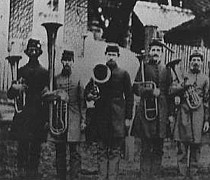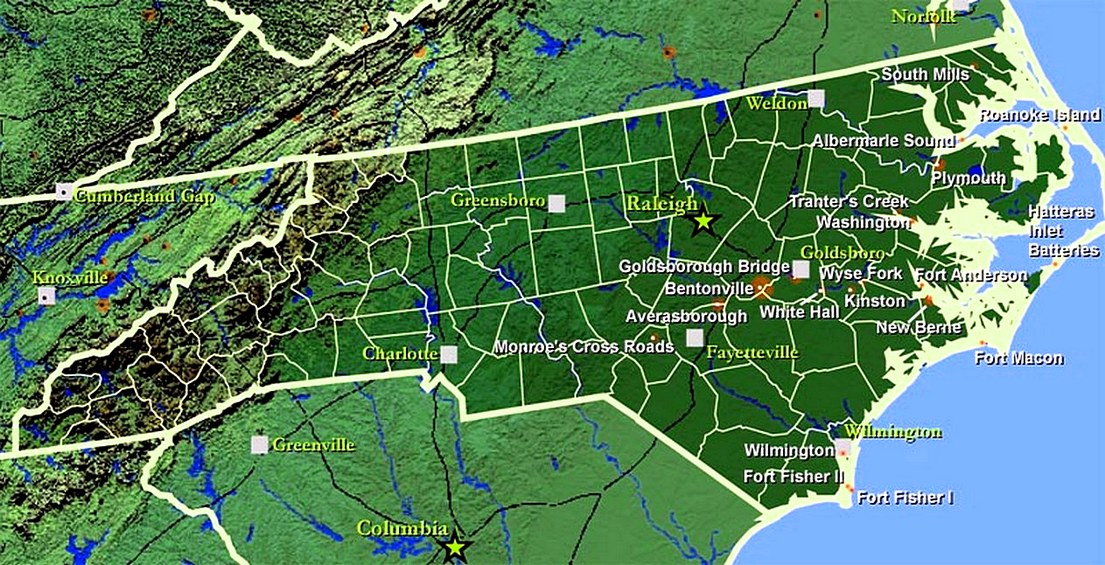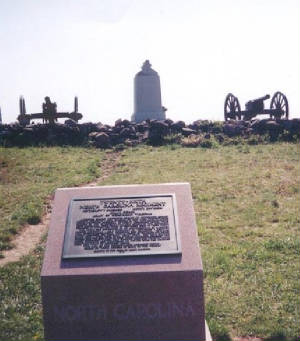|
26th North Carolina Infantry Regiment
| Band of the 26th North Carolina Regiment, C.S.A |

|
| 26th North Carolina Regimental Band, C.S.A |
26th Infantry Regiment was organized in August 1861 at "Crab Tree," a plantation three miles
from Raleigh, North Carolina. Its members were recruited in the counties of Ashe, Chatham,
Wilkes, Union, Wake, Caldwell, Moore, Alamance, Randolph, and Anson. A female Soldier also enlisted in the 26th. The regiment served at Fort Macon, on Bogue Island,
North Carolina, then fought at New Bern. During the war, it was assigned to General R. Ransom's, Pettigrew's, Kirkland's,
and MacRae's Brigade. It participated in the Seven Days Battles and conflicts at Rawls' Mills and Goldsboro. The 26th continued the "fight" under the command of the
Army of Northern Virginia from Gettysburg to Cold Harbor, took its place in the entrenchments south of the James River, and was involved in the final campaign at Appomattox. It lost 87 killed or wounded at New Bern, had 6 killed and 40 wounded during the Seven Days Battles, and of the 843 engaged at Gettysburg, more than eighty percent were disabled. The unit reported 16 killed and 83
wounded at Bristoe and on April 9, 1865, surrendered 10 officers and 120 men. Its commanders were
Colonels Henry K. Burgwyn,
Jr., John R. Lane, and Zebulon B. Vance. Colonel Zebulon Vance became North Carolina's Governor (1862-1865
and 1877-1879), and also served in the United States Senate from 1879-1892; Lieutenant Colonels James T. Adams and John T.
Jones; and Majors Abner B. Carmichael, James S. Kendall, and N. P. Rankin. The greatest loss sustained by any regiment
(North or South) during the war was the Twenty-sixth North Carolina Infantry
Regiment at Gettysburg; it advanced more than 800 men into action and
more than eighty percent were disabled.
| Civil War Map of North Carolina Battlefields |

|
| High Resolution Civil War Map of North Carolina Battlefields |
| 26th North Carolina Advance in Pickett's Charge |

|
| 26th North Carolina Memorial at Battle of Gettysburg |
(Right) This photograph shows
just how far the 26th advanced and just how close they came to the Union Lines during Pickett's Charge.
"We [26th North Carolina Infantry] went in with over 800 men in the regiment. There came out but 216, all
told, unhurt. Yesterday they were again engaged, and now have only about 80 men for duty."
Battle of Gettysburg report of Capt. J. J. Young, quartermaster, Twenty-sixth North Carolina Infantry on July 4, 1863
Below is the text on the monument to the 26th:
TWENTY-SIXTH
NORTH CAROLINA REGIMENT
PETTIGREW'S
BRIGADE HETH'S DIVISION
HILL'S
CORPS
ARMY OF NORTHERN VIRGINIA
ALTHOUGH NEARLY DESTROYED DURING ITS SUCCESSFUL ATTACK AGAINST
MEREDITH'S IRON BRIGADE ON JULY 1, THE TWENTY-SIXTH NORTH CAROLINA REGIMENT JOINED IN THE PETTIGREW-PICKETT CHARGE ON THE
AFTERNOON OF JULY 3. ADVANCING UNDER SOLID SHOT, SPHERICAL CASE, CANISTER, AND MUSKETRY THE REGIMENT CHARGED TO WITHIN
TEN PACES OF THE STONE WALL IN THEIR FRONT.
THE SCENE WAS DESCRIBED BY AN ARTILLERYMAN OF A RHODE
ISLAND
BATTERY: ". . . AS A REGIMENT OF PETTIGREW'S BRIGADE
(THE TWENTY-SIXTH NORTH CAROLINA) WAS CHARGING.
. .AND HAD ALMOST REACHED THE WALL JUST IN FRONT OF US, SERGE M.C.ONLEY CRIED OUT . . .'FIRE THAT GUN! PULL! PULL!' THE NO.
4 OBEYED
ORDERS AND THE GAP MADE IN THAT NORTH CAROLINA REGIMENT WAS SIMPLY TERRIBLE." UNDER THIS
GALLING FIRE, THE TWENTY-SIXTH NORTH CAROLINA WAS COMPELLED TO RETIRE WITH THE BRIGADE FROM THIS POINT TO SEMINARY RIDGE.
"THE MEN OF THE TWENTY-SIXTH REGIMENT WOULD
DRESS
THEIR COLORS IN SPITE OF THE WORLD."
ERECTED BY THE STATE OF NORTH CAROLINA
1986
Recommended Reading: Boy Colonel of the Confederacy. Description:
Henry King Burgwyn, Jr. (1841-63), the youngest colonel in the Army of Northern Virginia and one of the youngest
colonels of the American Civil War, died at the age of twenty-one while leading the Twenty-sixth North Carolina Infantry Regiment
into action at the Battle of Gettysburg. Continued below...
In this sensitive biography, originally published by UNC Press in 1985, Archie Davis provides a revealing
portrait of the young man's character and a striking example of a soldier who selflessly fulfilled his duty. Drawing on Burgwyn's
own letters and diary, Davis
also offers a fascinating glimpse into North Carolina society
during the antebellum period and the American Civil War.
Recommended Reading: Covered With Glory: The 26th North Carolina
Infantry at Gettysburg. Description: Award-winning historian, Rod Gragg, delivers a masterpiece with his
renowned study of the Fighting 26th. Rated a solid 5 STARS (highest possible
rating), Covered With Glory reflects vividly the fighting history of the
26th, led by General Robert E. Lee's youngest regimental colonel, 21-year-old Colonel Henry K. Burgwyn, Jr. Student,
Scholar, and Civil War Buff, this is a must have addition for your library. Continued below…
From Library Journal: Award-winning
historian Gragg offers yet another Civil War title. The 26th North Carolina saw action early in the war at New
Bern and Malvern Hill. On the first day at Gettysburg, it fought against
the 24th Michigan in McPherson's Woods. On the third and
final day, it participated in the infamous Pickett's Charge and suffered an 85 percent casualty rate, the highest of any regiment
in the Civil War. Besides recounting the enormous loss of life and the heroic deeds of many men, Gragg reveals the human side
of battle. Family diaries and letters describe the difficulties most soldiers faced in coping with military life. The author
uses an impressive list of other books and historical sources. What emerges is a detailed but readable history of a regiment
whose sacrifices and exploits merit studying. Recommended for its scholarship and depth of coverage to all academic and large
public libraries and to special collections.
Recommended
Reading:
Lee's Tar Heels: The Pettigrew-Kirkland-MacRae Brigade (Hardcover). Description:
The Pettigrew-Kirkland-MacRae Brigade was one of North Carolina's
best-known and most successful units during the Civil War. Formed in 1862, the brigade spent nearly a year protecting supply
lines before being thrust into its first major combat at Gettysburg.
There, James Johnston Pettigrew's men pushed back the Union's famed Iron Brigade in vicious
fighting on July 1 and played a key role in Pickett's Charge on July 3, in the process earning a reputation as one of the
hardest-fighting units in Robert E. Lee's Army of Northern Virginia. Continued below…
Despite suffering
heavy losses during the Gettysburg campaign, the brigade went on to prove its valor in a host of other engagements.
It marched with Lee to Appomattox and was among the last Confederate
units to lay down arms in the surrender ceremony. Earl Hess tells the story of the men of the Pettigrew-Kirkland-MacRae Brigade,
and especially the famous 26th North Carolina,
chronicling the brigade's formation and growth under Pettigrew and its subsequent exploits under William W. Kirkland and William
MacRae. Beyond recounting the brigade's military engagements, Hess draws on letters, diaries, memoirs, and service records
to explore the camp life, medical care, social backgrounds, and political attitudes of these gallant Tar Heels. He also addresses
the continuing debate between North Carolinians and Virginians over the failure of Pickett's
Charge. “[A] welcome addition for the student of the ANV, brigade histories, and Battle of Gettysburg. Will also be enjoyed greatly by the serious reader of the Civil War as well as casual
reader of American history.” americancivilwarhistory.org
Recommended Reading: Confederate
Military History Of North Carolina: North Carolina
In The Civil War, 1861-1865. Description:
The author, Prof. D. H. Hill, Jr., was the son of Lieutenant General Daniel Harvey Hill (North
Carolina produced only two lieutenant generals and it was the second highest rank in the army)
and his mother was General “Stonewall” Jackson’s wife's sister. In Confederate
Military History Of North Carolina, Hill discusses North Carolina’s massive task of preparing and mobilizing
for the conflict; the many regiments and battalions recruited from the Old North State; as well as the state's numerous
contributions during the war. Continued below...
During Hill's Tar Heel State
study, the reader begins with interesting and thought-provoking statistical data regarding the 125,000 "Old North State"
soldiers that fought during the course of the war and the 40,000 that perished. Hill advances with the Fighting Tar
Heels to the first battle at Bethel, through numerous bloody campaigns and battles--including
North Carolina’s contributions at the "High Watermark" at Gettysburg--and
concludes with Lee's surrender at Appomattox. Highly recommended!
Recommended Reading: The Life of Johnny Reb: The Common Soldier of the Confederacy (444
pages) (Louisiana State University Press) (Updated edition: November 2007) Description: The
Life of Johnny Reb does not merely describe the battles and skirmishes fought by the Confederate foot soldier. Rather,
it provides an intimate history of a soldier's daily life--the songs he sang, the foods he ate, the hopes and fears he experienced,
the reasons he fought. Wiley examined countless letters, diaries, newspaper accounts, and official records to construct this
frequently poignant, sometimes humorous account of the life of Johnny Reb. In a new foreword for this updated edition, Civil
War expert James I. Robertson, Jr., explores the exemplary career of Bell Irvin Wiley, who championed the common folk, whom
he saw as ensnared in the great conflict of the 1860s. Continued below...
About Johnny Reb:
"A Civil War classic."--Florida Historical Quarterly
"This book deserves to be on the shelf of every Civil War modeler and enthusiast."--Model
Retailer
"[Wiley] has painted with skill a picture of the life of the Confederate
private. . . . It is a picture that is not only by far the most complete we have ever had but perhaps the best of its kind
we ever shall have."--Saturday Review of Literature
Recommended Viewing: The Civil War - A Film by Ken Burns. Review: The
Civil War - A Film by Ken Burns is the most successful public-television miniseries in American history. The 11-hour Civil War didn't just captivate a nation,
reteaching to us our history in narrative terms; it actually also invented a new film language taken from its creator. When
people describe documentaries using the "Ken Burns approach," its style is understood: voice-over narrators reading letters
and documents dramatically and stating the writer's name at their conclusion, fresh live footage of places juxtaposed with
still images (photographs, paintings, maps, prints), anecdotal interviews, and romantic musical scores taken from the era
he depicts. Continued below...
The Civil War uses all of these devices to evoke atmosphere and resurrect an event that many knew
only from stale history books. While Burns is a historian, a researcher, and a documentarian, he's above all a gifted storyteller,
and it's his narrative powers that give this chronicle its beauty, overwhelming emotion, and devastating horror. Using the
words of old letters, eloquently read by a variety of celebrities, the stories of historians like Shelby Foote and rare, stained
photos, Burns allows us not only to relearn and finally understand our history, but also to feel and experience it. "Hailed
as a film masterpiece and landmark in historical storytelling." "[S]hould be a requirement for every
student."
Sources: Official Records of the Union and Confederate Armies; Walter Clark,
Histories of the Several Regiments and Battalions from North Carolina in the Great War 1861-1865; National Park Service: American
Civil War; National Park Service: Soldiers and Sailors System; Weymouth T. Jordan and Louis H. Manarin, North Carolina Troops,
1861-1865; and D. H. Hill, Confederate Military History Of North Carolina: North Carolina In The Civil War, 1861-1865.
|

